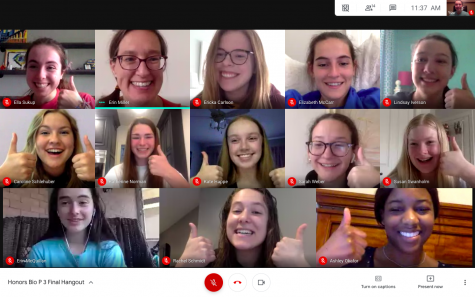Distance Learning: Pros and Cons
This past Spring on the Last Day of School, students in Ms. Malovrh’s AP European History Period 2 Class pose for a photo and spread the love!
January 7, 2021
The 2020-2021 school year will truly be remembered as a year like no other. Covid-19 has impacted people around the globe, and while the pandemic has had differing effects on everyone, no one’s life has been left untouched. Here at Vis, we’re lucky to have been in-person for the majority of the year, thanks to the hard work of our teachers, staff, and administrators (as well as students’ diligent mask-wearing and distancing). For most students, it has been a tumultuous time, as many have experienced the need to distance learn after being contact-traced, quarantined, or for other safety reasons. For teachers, the year has been even more difficult, as they have worked to prepare material teachable to students on Zoom, students in person, or classes in which there is a mix of those learning in-person and online.
While I think it’s safe to say that we all prefer being in the building, the reality is that in order to stop and/or limit the spread of this virus, we’ve needed to transition between learning modes, particularly around the holiday season. As we head back into distance learning, students reflect on their experiences learning from home, and the things they’ve liked—and disliked—about learning from a laptop.
Blurred Lines
As the pandemic has forced us to move nearly every activity online, the lines separating school/work and home life have been blurred, as we work in spaces usually meant for relaxing, eating, or sleeping. As an only child, I’ve been blessed with only having to fight for space in the house with my mom and dad; in the spring, I stuck to the living room, where I set up a card table and deemed it my “desk.” After shutting the doors and requiring everyone in the house to wear earbuds, I thought this worked fairly well, and it kept things relatively quiet for those of us who needed to work while others were on calls. Yet even for a family of three, this could be difficult. Calls would overlap, WiFi would go down, or mail would be delivered and the dog would go berserk and bark himself hoarse.
However, having three people (and a canine) under one roof seems like nothing compared to those with siblings and larger families. Senior Jane McMahon comes from a family of seven, and when the pandemic sent her two college-age siblings home from school, forced Jane and her younger brother and sister to learn from home, and moved her parents’ work online, things got crowded quickly.
Jane says, “My quarantine and distanced learning experience was shaped by my full house. Whether it was the WiFi being overworked or an argument with a sibling, it was difficult to have little time alone.” Trying to find a quiet space compatible with learning has been difficult for many, complicating the task of trying to work already made wearisome by hours on end of virtual learning.
Zoom Fatigue is Real
At the end of the Zoom school day, it’s not uncommon for many to feel a sort of exhaustion—even if they barely moved from one spot throughout the day. Zoom fatigue is a very real piece of the pandemic, and since the spring, students and those in the working world alike have struggled with spending many hours each day in front of a screen.
Experts explain that this is due to our brains experiencing a sort of “fake-out,” in that while we see each other and can have a conversation as normal, we aren’t physically together. It takes more effort to focus on the visual cues that are parts of a conversation, such as facial expressions, tone of voice, or body language, and in dedicating our energy to focus on these aspects, we aren’t able to hold a conversation as effortlessly. Additionally, there is a somewhat eerie feeling of knowing that we are constantly being watched. This can make speaking feel almost like a performance, increasing stress-levels and nervousness and exacerbating the feeling of exhaustion once the call is finished.
Seniors
It’s no secret that every student is missing out on the classic high school experience, but for seniors, in particular, this year has been rough. There are the obvious losses—lockers, common spaces, events such as homecoming, dances, and sports rallies—as well as the not-so-apparent forfeitures. So much of Vis is made up of the little moments throughout the day, and it is the lack of these times where the loss has felt most acute.
Senior Jacqueline Tsai reflects on this, saying, “All the memories of school take place in the senior commons, during passing time, and seated in a random amalgamation of girls at a lunch table.” The sharing of snacks at break, hubbub of noise and activity as students pack into the auditorium for assembly, or simply collapsing onto a couch with friends after a long day are all moments that have been lost due to Covid. As seniors try and savor their last months at Vis, these little tidbits are often missed most, as Zoom simply cannot provide virtual couches, snacks, or the feeling of just being together.
Pajama Day, Every Day
This spring, it wasn’t only Vis students who ditched their uniforms—people around the world who found themselves working from home began to master the Zoom dress code. Sweatshirts, sweatpants, and many other comfy clothing items were brought to the forefront of wardrobes, as Vis students exchanged the classic navy sweaters and pleated skirts for Comfys and our well-worn Sperrys for cozy slippers. This school year, things are a little different, as those learning from home are required to wear their uniform; thus, students in all grades were delighted when it was announced that distance learning around the holidays would come with the privilege of being out of uniform. It’s a pretty much universal truth—everyone loves going to math class in pajamas.
Found Time
Distance learning may have its setbacks, but one thing that the majority of people can agree on is the fact that there is a large chunk of time gained. It may not seem like it, but the 15- to 30-minute (or more!) commute that many Vis students face each day is a significant amount of time, and being able to ditch the now-freezing drive in the morning is not exactly something to be mourned. For the select few who enjoy setting their alarm for 8:12, rolling out of bed and throwing on clothes, and sliding into their seat (or, rather, clicking open Zoom) at 8:20 on the dot, distance learning is a perk.
Over the course of the spring, as well as in the past few weeks as we’ve transitioned to distance and hybrid learning, I’ve found myself getting more sleep and feeling much more rested, as have many other students. In addition to having more time in the morning, losing the after-school drive time is helpful, too, as many are appreciative of the ability to jump into after-school activities or routines right away.
Junior Ella Sukup enjoyed being able to head out on a run or hop on her Zoom soccer practice without having to worry about hurrying home from school, as she usually deals with a twenty- to thirty-minute commute. Others say they enjoyed the free time throughout the day; during a study hall, break, or lunch, many students headed outside to take a walk or get some fresh air, and some even Zoomed into class from the outdoors!

We Are Family
For many, this spring brought the return of elder siblings or other family members, reunited under one roof. This came with its own set of challenges, but many enjoyed the increased amount of time with family. Puzzles, board games, and other non-virtual activities came to the forefront of the entertainment sphere, as well as individual interests such as reading or exercising.
Jane McMahon acknowledges her gratitude for the ability to simply have others with whom to share the experience of living through a pandemic: “I was lucky to have [my family] for comfort and to bring me joy in such a difficult time. Especially when looking at my two grandmothers who have both had to live alone throughout the pandemic, I consider myself very lucky to have had my family around.” For some, it may be a tossup as to how much they relished the constant presence of others around the house, but the fact can’t be denied that this pandemic has brought us all back together, and for many, strengthened bonds within families.
One thing can be agreed upon—distance learning isn’t favored by anyone. Students and teachers alike are anxiously awaiting the day we can all be back together, distancing no longer necessary and masks thrown by the wayside. But until then, as we navigate the pandemic and different learning modes, we can try and look for the upsides. Whether it’s a uniform of sweatpants, the opportunity to spend more time outdoors, or increased bonding time with family, there are upsides brought by distance learning that may very well be missed when we return to school in person, for good.
Works Cited
Jiang, Manyu. “The Reason Zoom Calls Drain Your Energy.” BBC Worklife, BBC, 22 Apr. 2020, www.bbc.com/worklife/article/20200421-why-zoom-video-chats-are-so-exhausting.


















